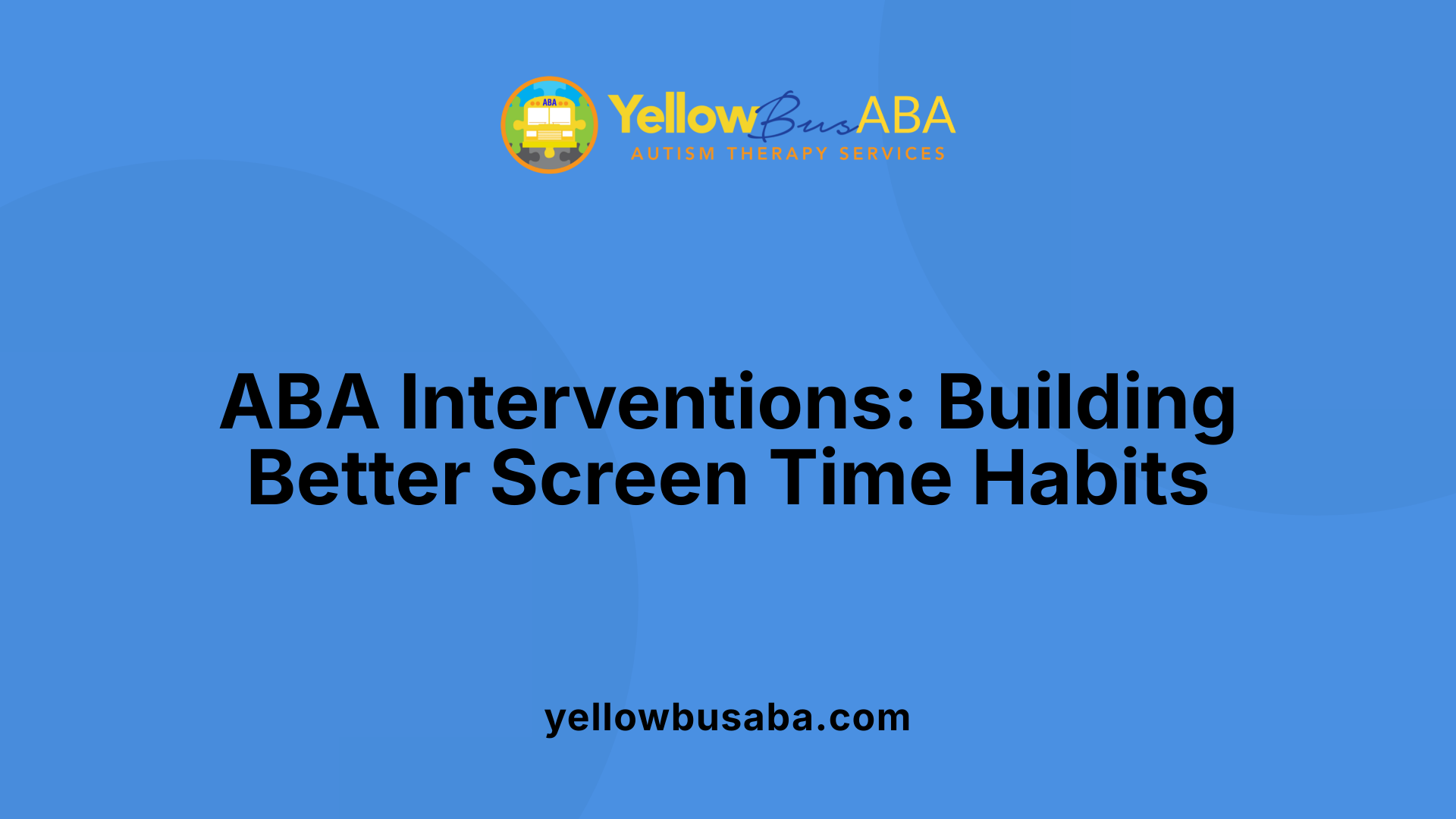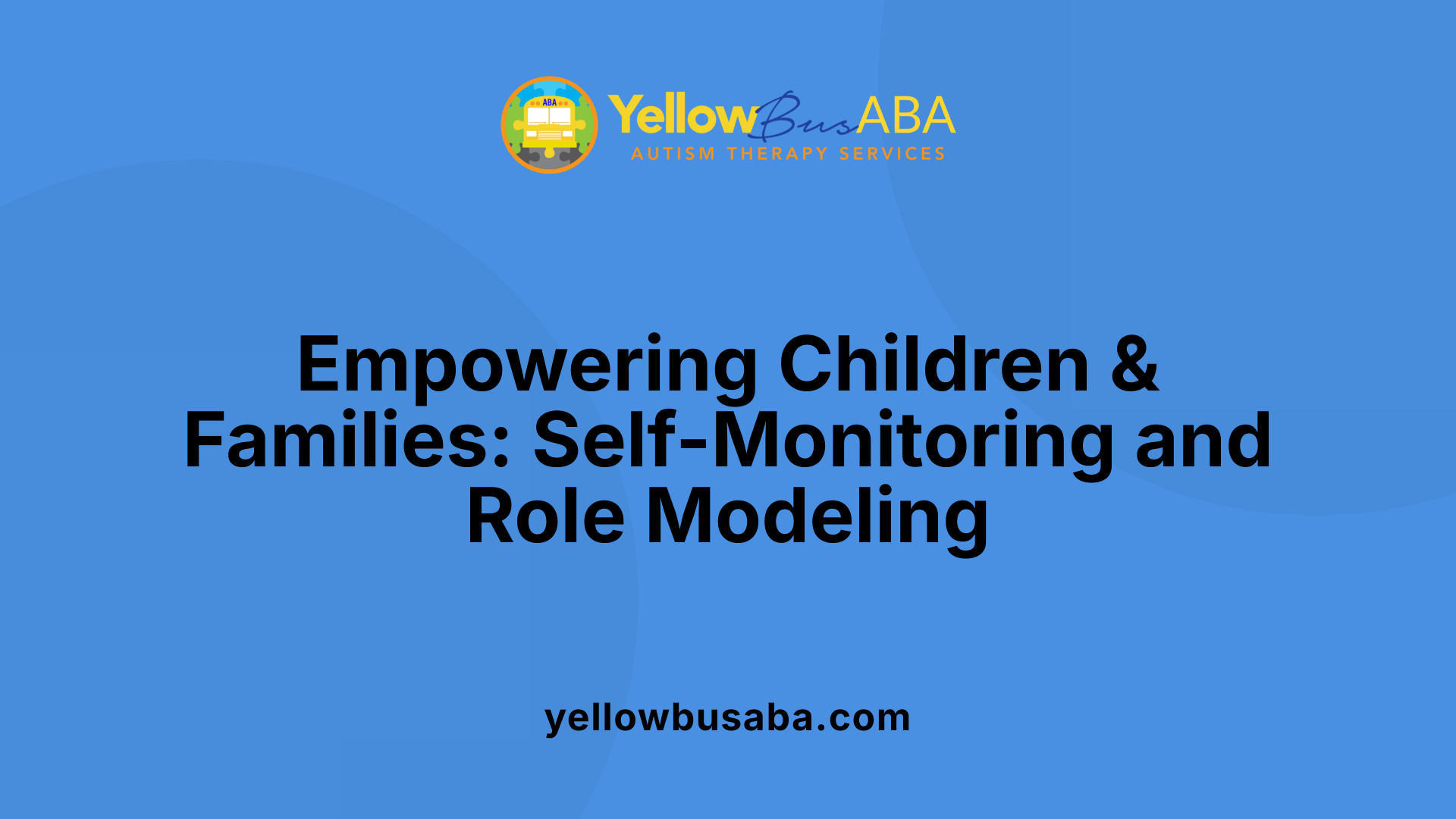Understanding the Importance of Managing Screen Exposure
In today’s digital age, managing children’s screen time is crucial, especially for children with autism. Excessive screen exposure can impact their cognitive, emotional, and social development. Applying Applied Behavior Analysis (ABA) strategies offers a systematic and effective pathway to promote healthier habits, fostering developmentally beneficial behaviors while reducing reliance on screens.
Framework of ABA Strategies in Screen Time Reduction

Why is it beneficial to limit screen time for children's development and well-being?
Limiting screen time offers numerous benefits for children’s overall growth and health. It helps promote better sleep habits and reduces eye strain caused by prolonged device use. Cutting back on screens lowers the risk of obesity and related health issues by encouraging more physical activity. It also enhances focus and cognitive skills, supporting academic success by minimizing distractions and encouraging active engagement in learning and play.
Social skills, face-to-face communication, and emotional recognition also improve when children spend less time on screens. This helps them develop healthier social interactions and emotional understanding. For younger children, reducing screen exposure can prevent delays in language development and attention-related issues. It fosters family bonding and outdoor play, essential elements of a balanced lifestyle. Overall, managing screen time supports children’s physical, emotional, social, and mental development, creating a foundation for healthier adulthood.
How should practitioners implement ABA strategies to effectively manage and reduce screen time?
Practitioners aiming to reduce screen time effectively should start with comprehensive assessments of the child's current habits. This involves tracking how much and what type of content the child engages with daily. Based on this data, they can develop personalized goals to decrease excessive use.
A fundamental technique is behavior substitution; replacing screen time with other enriching activities like drawing, playing musical instruments, or physical exercises such as trampoline exercises and nature walks. These alternatives support motor skills and emotional regulation. Reinforcing these behaviors through praise or rewards encourages continued engagement in non-screen activities.
Establishing well-structured routines is essential. This includes setting specific times for screen use, creating screen-free zones, and scheduling regular breaks with physical or creative activities. Using visual aids like schedules and timers can help children understand boundaries and routines.
Collaborating with caregivers is crucial. Educating parents and family members on role modeling healthy habits enhances consistency. Involving professionals such as ABA therapists ensures tailored strategies that align with the child's developmental needs. Tools like the 'Moment' app or parental controls can assist in monitoring and managing device use.
Employing action planning and goal setting—such as aiming for a specific reduction in daily screen time—can motivate children and families. Encouraging self-monitoring through discussions about acceptable content and setting clear expectations fosters independence.
This integrated approach, combining behavioral strategies, family involvement, and environmental modifications, provides a solid foundation for promoting healthier screen time habits among children, especially those with autism.
Practical Techniques to Reduce Screen Time with ABA

What are some practical techniques for managing and decreasing screen time with ABA methods?
Implementing effective strategies requires a combination of clear rules, visual supports, and reinforcement techniques. Setting consistent, well-defined boundaries helps the child understand the limits of screen use. Using visual schedules and timers provides predictable cues and helps in transitioning between activities.
For example, visual schedules can outline daily routines, including designated times for screen use and alternative activities like play or hobbies. Timers serve as visual and auditory reminders, signaling when screen time should start or end, which encourages independence and self-regulation.
Reinforcing the participation in preferred offline activities, such as drawing, building, or outdoor sports, encourages children to develop alternative behaviors. Positive reinforcement—like praise or tangible rewards—motivates children to engage more in non-screen activities.
Furthermore, creating structured routines by planning daily activities involving the child provides stability and predictability. When children know what to expect, they are less likely to seek screens for entertainment.
Experts also recommend involving professionals to tailor these techniques to each child's unique needs. Collaborating with behavior analysts can help develop individualized strategies that support developmental goals and improve overall well-being.
How can visual supports improve compliance with screen time boundaries?
Visual supports such as schedules, visual timers, and countdown charts act as effective tools to help children adhere to screen time rules. These cues clarify when screen time begins and ends, making transitions smoother and reducing potential frustration or resistance.
For children with autism, visual supports enhance understanding and predictability, which decreases anxiety related to changes. When a child sees a visual cue indicating that screen time is ending, they are more likely to comply without tantrums or refusal.
Moreover, these tools promote independence. As children learn to monitor their own behavior through visual cues, they develop self-management skills that support healthier screen habits over the long term. Regular use of visual supports also encourages self-awareness and responsibility, making it easier for families to enforce boundaries consistently.
In addition, visual supports can be complemented with social stories or discussion about appropriate content, helping children understand why these boundaries matter, fostering cooperation and respecting limits.
Behavioral Techniques and Interventions for Decreasing Screen Time

What are effective ABA techniques for reducing excessive screen use?
Applied Behavior Analysis (ABA) offers several strategies to help reduce excessive screen time, especially in children with autism. One effective method is differential reinforcement of alternative behaviors (DRA). This technique involves reinforcing preferred offline activities, such as playing with toys, drawing, or engaging in physical play, instead of screen use. By consistently rewarding these alternative behaviors, children learn to prefer healthier activities.
Another approach is behavioral momentum, which involves starting with easy, preferred tasks to build confidence and then gradually introducing more challenging activities that do not involve screens. Visual supports like schedules and timers also facilitate understanding and help children anticipate their screen time limits, making transitions smoother.
In addition, goal setting and action planning involve working with caregivers to establish clear, achievable objectives for reducing screen use. Social support, through modeling healthy habits by parents or peers, reinforces the desired behaviors. For example, parents can demonstrate unplugged activities, making these alternatives more attractive.
Behavior substitution is a core component—replacing screen time with interests such as outdoor play, reading, or creative hobbies. Systematic response interruption or extinction can also be employed to reduce problematic screen behaviors, especially when combined with reinforcement for engaging in suitable activities.
Together, these ABA techniques create a structured environment that promotes healthier routines and reduces reliance on screens.
How do reinforcement and modeling promote lasting behavior change?
Reinforcement and modeling are foundational elements that support sustainable changes in behavior. Positive reinforcement involves providing praise, rewards, or privileges when children engage in desired offline activities. This positive feedback increases the likelihood that these behaviors will recur, gradually replacing screen time.
Modeling complements reinforcement by demonstrating appropriate behaviors. When caregivers or peers actively engage in healthy activities, children observe and imitate these actions. For instance, a parent reading a book or playing outdoors sets a visual example that children can emulate, understanding that such activities are acceptable and rewarding.
Consistent routines that incorporate visual supports, along with reinforcement and modeling, help establish new habits. Over time, children internalize these behaviors, leading to decreased screen time and increased participation in enriching activities. This combination fosters more personal autonomy in managing behaviors, making the change more enduring.
| Technique | Description | Effectiveness | Additional Notes |
|---|---|---|---|
| Differential reinforcement | Rewards alternative behaviors | Promotes use of preferred activities | Reinforce offline play instead of screens |
| Behavioral momentum | Build success with simple tasks | Encourages engagement in complex activities | Start with easy, enjoyable tasks |
| Modeling | Demonstrate desired behaviors | Encourages imitation | Caregivers' behaviors influence children |
| Reinforcement | Positive feedback for desired behaviors | Strengthens habits | Use verbal praise, tokens, or privileges |
| Routines | Consistent daily schedules | Creates structure | Reinforces expectations |
| Visual supports | Schedules, timers, visual cues | Aids understanding and compliance | Clarify limits and routines |
In conclusion, combining these strategies within a supportive environment enables children to develop healthier habits and reduces screen exposure over time.
Environmental and Routine Modifications
How can modifying the environment help in reducing screen exposure?
Adjusting the physical setting where children with autism spend their time can significantly decrease their screen exposure. Removing devices from bedrooms means children are less likely to access screens during unstructured times or late at night, promoting better sleep and healthier routines. Limiting device access to common areas helps caregivers monitor usage more effectively and set clear boundaries.
Rotating toys and activities is another effective strategy. By regularly changing the available toys or engaging activities, children remain interested and less likely to seek stimulation from screens out of boredom. This approach supports sustained engagement in varied, enriching activities.
Creating structured routines is essential for modeling predictability and understanding. Establishing daily schedules that include designated times for play, learning, physical activity, and relaxation helps children manage expectations and reduces their tendency to default to screens. When children understand what comes next and see consistent boundaries, they are less likely to use screens excessively.
What role does routine and environment play in decreasing screen time?
The routines and physical environment surrounding a child with autism play a central role in behavioral change. When consistent schedules are implemented, children learn when and how to engage in different activities, which fosters a sense of security and minimizes resistance.
Modifying the environment by designating specific areas for screen use and restricting access in private spaces encourages self-regulation. Limiting device availability supports the enforcement of boundaries and promotes social interactions, physical activity, and creative play.
Furthermore, environments that support rotate-and-reuse strategies for toys and activities help maintain interest and prevent boredom—a common trigger for screen seeking. Combining these environmental adjustments with structured routines reinforces positive habits, making it easier for children to gradually decrease their reliance on screens.
| Strategy | Description | Effect on Screen Time |
|---|---|---|
| Removing devices from bedrooms | Devices kept in shared, monitored areas | Reduces access, encourages social play |
| Rotating toys and activities | Changing available toys regularly | Prevents boredom, promotes varied interests |
| Establishing routines | Daily schedules with set activity times | Creates predictability, reduces default screen use |
Implementing these changes provides a supportive environment conducive to healthier behavioral patterns. It fosters independence, creativity, and social engagement, aligning with development goals for children with autism.
Encouraging Self-Monitoring and Family Involvement

How can children learn to self-monitor their screen use?
Teaching children to self-monitor their screen time is an essential component of developing healthy online habits. Setting clear expectations about content and usage helps children understand boundaries and develop self-regulation skills.
Parents and caregivers can initiate discussions about what is considered acceptable content, such as educational videos or creative activities, and what should be avoided. Implementing tools like parental controls and regularly reviewing media usage encourages children to make informed decisions.
Encouraging self-monitoring also involves guiding children to recognize when they have exceeded their limits and to adopt strategies to pause or stop screen activity. This can include setting timers or visual cues that remind them to take breaks.
Through consistent practice and reinforcement, children learn to manage their screen habits independently. Over time, they develop autonomy, better judgment about their consumption, and skills to self-regulate, which are crucial for their long-term well-being.
How do family members influence children's screen habits?
Family members play a vital role in shaping children’s screen behaviors through role modeling and active engagement. When parents and caregivers demonstrate balanced screen use, such as limiting their own device time and participating in offline activities, children observe and imitate these behaviors.
Active family participation involves setting clear rules, establishing routines, and consistently monitoring children’s usage. Engaging in alternative activities like outdoor play, board games, or interactive hobbies not only reduces screen time but also fosters family bonds.
It’s important for the entire family to create a supportive environment that prioritizes social interaction, physical activity, and creative pursuits. When children see their caregivers valuing these activities, they are more likely to adopt similar habits.
A cohesive family approach ensures children internalize healthy routines, making it easier to manage their screen time effectively and promote overall development.
Strategies for setting content expectations and using parental controls
Establishing clear content expectations helps children understand what is appropriate and safe online. Having open discussions about the types of media they can access fosters transparency and trust.
Using parental controls, such as device restrictions and app management, reinforces these expectations. Tools like media reviews or scheduled device usage times help children adhere to agreed-upon boundaries.
Regularly reviewing media and discussing online experiences encourage children to reflect on their media choices, promoting responsible digital citizenship.
Involving family members in monitoring
Involving multiple family members in monitoring helps create consistency and accountability. Assigning roles like tracking screen time or discussing content with the child ensures that monitoring is comprehensive.
Family involvement can also include shared activities that serve as alternatives to screens, such as outdoor adventures or family game nights. These activities reinforce the importance of quality interactions and physical activity.
By working together, families can support children in developing self-awareness about their screen habits while fostering a healthy environment conducive to personal growth and social connection.
Summarizing Benefits and Future Directions

What are the benefits of limiting screen time for children’s development?
Limiting screen time offers numerous positive effects on children’s overall development and well-being. It helps establish healthier sleep patterns by reducing exposure to screens before bedtime, which can improve sleep quality and duration. Decreasing screen time also lessens eye strain and reduces the risk of obesity and obesity-related health issues by encouraging more physical activity.
Reduced screen exposure allows children to focus better, enhances cognitive functions, and can improve academic outcomes by minimizing distractions. It encourages face-to-face social interaction, essential for developing social skills, recognition of emotions, and effective communication.
Moreover, limiting screen time can prevent developmental delays, such as language, attention, and behavioral issues. It nurtures meaningful family connections through shared activities and outdoor play, fostering a balanced environment for healthy growth.
What are promising avenues for future behavior change interventions using ABA?
Future interventions in reducing screen time are increasingly focusing on incorporating Behavior Change Techniques (BCTs) proven effective in past research. Techniques such as behavior substitution—encouraging alternative activities like reading or playing musical instruments—are promising. Demonstrations of desired behaviors and providing information about potential social and environmental outcomes help build understanding and motivation.
Goal setting and action planning are crucial for establishing achievable targets and routines that support decreased screen use. Social support, whether through family involvement or peer groups, reinforces positive changes.
Enhancing parental self-efficacy and role modeling remains vital. Models involving visual supports, reinforcement strategies, and stakeholder participation contribute to sustainable behavior change.
By tailoring these techniques to individual needs and environments, future ABA-based programs can more effectively help children adopt healthier habits, supporting their cognitive, emotional, and social development.
How can improvements in behavioral strategies be integrated into future interventions?
Integrating advancements in ABA involves systematic application of techniques that directly influence behavior patterns. Visual supports can help children understand expectations, while reinforcement strategies encourage preferred behaviors. Frequent monitoring and feedback, such as using tools to track screen time, allow families to adjust strategies dynamically.
Environmental modifications, like removing devices from bedrooms or limiting their use to common areas, make behaviors easier to adopt. Rotating toys and activities prevent boredom and divert attention from screens. Discussions about acceptable content skills build self-monitoring capabilities.
Involving parents and caregivers as active participants enhances intervention effectiveness. Training on how to implement behavior substitution, establish routines, and provide positive reinforcement contributes to sustained change.
Future interventions should also consider technological innovations, such as media reviews and parental control tools, to support self-regulation. Combining practical strategies with behavioral science principles will pave the way for more effective, personalized approaches.
| Aspect | Approach | Benefits | Additional Notes |
|---|---|---|---|
| Behavior substitution | Offering alternatives (drawing, sports) | Promotes problem-solving and emotional growth | Focuses on replacement activities |
| Visual supports | Schedules and visual cues | Clarifies expectations, enhances understanding | Useful for young children |
| Reinforcement & Monitoring | Apps and feedback | Encourages compliance | Reinforces positive behaviors |
| Environment modification | Removing devices from private spaces | Facilitates better supervision | Reduces temptation |
| Parental involvement | Goal setting, role modeling | Builds self-efficacy | Ensures sustainability |
Incorporating these strategies based on current research and future innovations will continue to improve interventions aimed at reducing screen time, ultimately fostering healthier, well-rounded development in children.
Building a Balanced Digital Environment
Implementing ABA strategies for managing and reducing screen time provides a structured, effective framework that fosters healthier habits in children with autism. Combining environmental modifications, visual supports, positive reinforcement, and family involvement creates a comprehensive approach to promote meaningful behavioral change. Future interventions that incorporate promising ABA techniques and tailor strategies to individual needs hold the potential to optimize outcomes, supporting children’s overall development and well-being. Embracing these evidence-based methods can lead to a balanced, enriching environment where children thrive physically, socially, and emotionally.
References
- Practical Ways to Reduce Screen Time for Autism - Silver Swing ABA
- 5 Behavioral Strategies to Reduce Screen Time - ABA Learning Lab
- What behavior change techniques are associated with effective ...
- How to Handle Screen Time with Your Child with Autism
- Practical Ways to Reduce Screen Time for Autism - Silver Swing ABA
- How to Manage Screen Time for Kids With Autism | Aim Higher ABA
- How to Manage Screen Time for Kids With Autism | Aim Higher ABA
- Practical Ways to Reduce Screen Time for Autism - Silver Swing ABA
- What behavior change techniques are associated with effective ...
- How to Manage Screen Time for Kids With Autism | Aim Higher ABA






